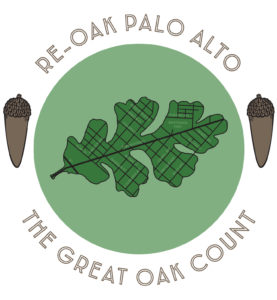- About Us
- Our Work
- Tree Info
- Get Involved
- Blog
- Volunteer
- Support Us
By Canopy Team on September 19, 2017

Welcome to our 4-part Oaktober Series dedicated to oaks! Check out tips on how to care for your California native oak in our second post, or read about why we care about oaks in our third post. Stay tuned for the final post in the series where we’ll divulge details on the pilot launch of The Great Oak Count and how you can get involved.
Notice the trees as the fall season approaches – the scarlet and red oak leaves change to vibrant autumnal hues, the valley oak’s lobed leaves litter the ground, and the new crop of acorns crunch under our shoes.
This October, we are celebrating the splendor of oak trees and all that they contribute to the urban ecosystem. Our native oaks are particularly special, so we’re taking some time this month to pay tribute. Locally native oaks including the Black Oak, Blue Oak, Coast Live Oak, and Valley Oak are ecologically unparalleled, bringing grace and greenery to many of our Mid-Peninsula cities.
Black Oak (Quercus kelloggii): The black oak is highly drought-tolerant and the most widely distributed of all oaks in the west, growing in most areas throughout California. The tree is deciduous and can grow up to 80 feet in height with a broad, rounded crown. Acorns from the black oak were preferred by the Native Americans and a common staple of their diet.
Blue Oak (Quercus douglasii): Especially suited to withstand hot temperatures, this native oak is typically found growing in areas such as valleys and coastal ranges. The slow growing blue oak is deciduous and noted for its sparse foliage with a blue tint.
Coast Live Oak (Quercus agrifolia): The coast live oak is an evergreen tree that grows relatively quickly to 70 feet with an equal spread. Although truly an evergreen, its leaves persist for only one year then fall from the tree when new growth starts in the spring. A setting of no vegetation and no irrigation around the base, is ideal for this species. The Coast Live Oak is adapted to very little water in the summer and should not be irrigated during dry months.

Valley Oak (Quercus lobata): Considered the monarch of California oaks by virtue of its size, age, and beauty. The valley oak is a deciduous tree that loses its leaves in the winter and is considered a protected species by the City of Palo Alto. Ideally, the tree should have no summer irrigation underneath it. Watering of other plants around its base can cause root crown fungus, leading to the death of the tree.
Trees are one of the most significant living forces in our environment. In our region, oaks in particular have played a key role in supporting local ecosystems and sustaining a diverse web of native wildlife. Additionally, native oaks are well adapted to the California environment of dry summers and periods of drought. They are able to thrive with less water than other trees in the urban environment, contributing to a reduced need for irrigation.
Yet over the last two centuries, once prevalent oak woodlands have been largely eliminated, first by agricultural conversion, and later by rapid development and urbanization. Today, there is increasing recognition that re-integrating oaks in our parks and urban landscapes promises a host of benefits, both for wildlife and for people.

Celebrate Oaktober with us and join one our upcoming oak-tastic events!
CANCELLED – Tree Walk: Oaks of Stanford (Sunday, October 15): Stanford University is home to a rich mosaic of trees species, including an impressive, and increasing, variety of oaks. Join expert arborist and oak specialist Dave Muffly as we explore a decade of experimentation with new oak species at Stanford. RSVP to attend. Update 10/13/17: Unfortunately this event was cancelled due to unhealthy air quality forecasts. We hope to reschedule and will post updates as soon as possible!
Tree Planting: Kavanaugh Neighborhood Planting (Saturday, October 21): Join Canopy as we plant a new generation of street trees in East Palo Alto’s Kavanaugh neighborhood. Together we create stronger, healthier communities by bringing the life-giving benefits of trees to the places we live. Sign up to volunteer.
 Tree Survey: The Great Oak Count (Saturday, October 28): Join Canopy for the launch of the most comprehensive survey of native oaks in the bay area! This citizen science effort will collect valuable information about our native oak population, which scientists can use to evaluate how our urban forest ecosystem has changed since Canopy first surveyed Palo Alto’s oaks over 20 years ago. Sign up to volunteer.
Tree Survey: The Great Oak Count (Saturday, October 28): Join Canopy for the launch of the most comprehensive survey of native oaks in the bay area! This citizen science effort will collect valuable information about our native oak population, which scientists can use to evaluate how our urban forest ecosystem has changed since Canopy first surveyed Palo Alto’s oaks over 20 years ago. Sign up to volunteer.
For complete events details or to sign up, visit our calendar.
Join in and share photos of oaks! Tag us @CanopyTreesForAll on Facebook, or @CanopyTrees on Instagram and Twitter, and be sure to use #Oaktober.
Stay tuned for our next post that will dive into the valuable role of oaks in our ecosystems, shining light on how people can play a part in enhancing our cities through re-oaking.